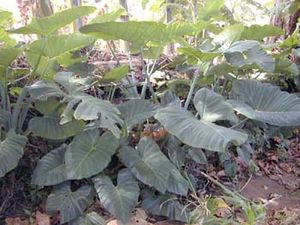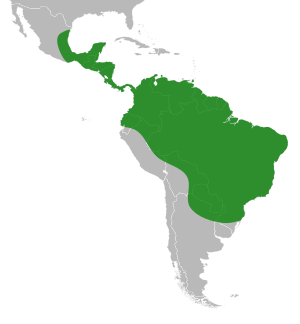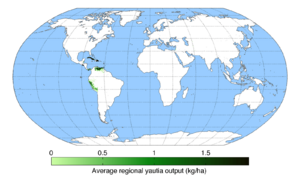Xanthosoma facts for kids
Quick facts for kids Xanthosoma |
|
|---|---|
 |
|
| Xanthosoma roseum 'Elephant ear' | |
| Scientific classification |
|
| Kingdom: | Plantae |
| Clade: | Tracheophytes |
| Clade: | Angiosperms |
| Clade: | Monocots |
| Order: | Alismatales |
| Family: | Araceae |
| Subfamily: | Aroideae |
| Tribe: | Caladieae |
| Genus: | Xanthosoma Schott |
 |
|
| Range of the genus Xanthosoma | |
| Synonyms | |
|
|
Xanthosoma is a group of flowering plants that belong to the arum family, called Araceae. These plants originally come from tropical parts of America. However, people now grow them in many other warm, tropical areas around the world.
Many Xanthosoma plants are grown for their starchy, underground stems called corms. These corms are a very important food in tropical regions. You might hear them called by different names like malanga, cocoyam, tannia, yautía, or macabo.
Other types of Xanthosoma, especially Xanthosoma roseum, are grown just for their beauty as ornamental plants. People often call these plants 'ape' or 'elephant ear'. This is because their large leaves look a bit like an elephant's ear. Sometimes, plants from similar groups like Caladium, Colocasia (which is taro), and Alocasia are also called 'elephant ear'.
The leaves of most Xanthosoma plants are quite large, usually between 40 and 200 centimeters long. They are often shaped like an arrowhead. Unlike the leaves of Colocasia plants, Xanthosoma leaves usually have a small V-shaped notch at the top. This notch goes all the way to where the leaf stem connects to the main part of the leaf.
Contents
How Xanthosoma Plants Reproduce
Xanthosoma plants have a special flower structure called an spadix. This spadix has different parts for reproduction. At the bottom, there are female flowers. In the middle, there are special flowers that don't make seeds but offer a reward to insects that help with pollination. At the top, there are male flowers.
Before the flower opens, it is covered by a leaf-like part called a spathe. When the flower is ready, the top part of the spathe opens up. This shows the male flowers. The bottom part of the spathe stays closed, forming a small room around the female flowers and the reward flowers.
These flowers are usually open for two nights. On the first night, the female flowers are ready to be pollinated. They produce heat and a sweet smell. This attracts special beetles called dynastine beetles (Cyclocephala species). These beetles arrive covered in pollen from another Xanthosoma flower. They stay inside the spathe's closed room for about 24 hours. While they are there, they pollinate the female flowers as they eat from the reward flowers.
On the second night, the beetles come out of the spathe's room. They walk over the male flowers, getting covered in new pollen. Then, they fly off to find another freshly opened Xanthosoma flower nearby. This helps the plants spread their pollen and make new seeds.
It takes several months for the fruits to grow and ripen. The fruits start to develop inside the spathe's tube. When they are ready, the spathe tube often rolls open. This shows the bright orange fruits and the soft, pink inside of the spathe.
Types of Xanthosoma Plants
There are many different kinds of Xanthosoma plants. Scientists have given each one a special name. Here are some of the accepted species:
- Xanthosoma acutum - Found in French Guiana and Brazil.
- Xanthosoma akkermansii - Found in Venezuela.
- Xanthosoma aristeguietae - Found in Venezuela and Brazil.
- Xanthosoma auriculatum - Found in Brazil.
- Xanthosoma baguense - Found in Peru.
- Xanthosoma bayo - Found in Venezuela.
- Xanthosoma belophyllum - Found in Colombia, Venezuela, and the Guianas. It also grows wild in the Dominican Republic.
- Xanthosoma bilineatum - Found in Colombia.
- Xanthosoma bolivaranum - Found in Venezuela.
- Xanthosoma brasiliense – Also known as Tahitian spinach. Found in the Lesser Antilles, Puerto Rico, Hispaniola, Trinidad & Tobago. It also grows wild in southern Brazil.
- Xanthosoma brevispathaceum - Found in Peru.
- Xanthosoma caladioides - Found in Panama.
- Xanthosoma caracu – Also known as yautia horqueta. Found in Puerto Rico and the Dominican Republic.
- Xanthosoma caulotuberculatum - Found in Venezuela.
- Xanthosoma conspurcatum - Found in Venezuela, Suriname, and French Guiana.
- Xanthosoma contractum - Found in Bolívar State of Venezuela.
- Xanthosoma cordatum - Found in Guyana and French Guiana.
- Xanthosoma cordifolium - Found in Guyana.
- Xanthosoma cubense - Found in Cuba.
- Xanthosoma daguense - Found in Colombia and Ecuador.
- Xanthosoma dealbatum - Found in Costa Rica.
- Xanthosoma eggersii - Found in Ecuador.
- Xanthosoma exiguum - Found in Amazonas State of Venezuela.
- Xanthosoma flavomaculatum - Found in Colombia.
- Xanthosoma fractum - Found in Peru.
- Xanthosoma granvillei - Found in French Guiana.
- Xanthosoma guttatum - Found in Valle del Cauca in Colombia.
- Xanthosoma hebetatum - Found in Valle del Cauca in Colombia.
- Xanthosoma helleborifolium – Also known as belembe silvestre. Found from Costa Rica south to central Brazil. It also grows wild in the West Indies.
- Xanthosoma herrerae - Found in Colombia.
- Xanthosoma hylaeae - Found in Colombia, Ecuador, Peru, Bolivia, and northwestern Brazil.
- Xanthosoma latestigmatum - Found in Venezuela.
- Xanthosoma longilobum - Found in Venezuela.
- Xanthosoma lucens - Found in Rondônia.
- Xanthosoma mafaffoides - Found in Amazonas State of Venezuela.
- Xanthosoma mariae - Found in Peru.
- Xanthosoma maroae - Found in Amazonas State of Venezuela.
- Xanthosoma maximiliani - Found in eastern Brazil.
- Xanthosoma mendozae - Found in México State in central México.
- Xanthosoma mexicanum - Found in Chiapas, Oaxaca, Central America, Colombia, and Venezuela.
- Xanthosoma narinoense - Found in Colombia.
- Xanthosoma nitidum - Found in Venezuela.
- †Xanthosoma obtusilobum - Found in Mexico, but probably extinct.
- Xanthosoma orinocense - Found in Amazonas State of Venezuela.
- Xanthosoma paradoxum - Found in Colombia.
- Xanthosoma pariense - Found in Venezuela.
- Xanthosoma peltatum - Found in Venezuela.
- Xanthosoma pentaphyllum - Found in Brazil.
- Xanthosoma platylobum - Found in Brazil.
- Xanthosoma plowmanii - Found in Brazil.
- Xanthosoma poeppigii - Found in Peru, Bolivia, and northwestern Argentina.
- Xanthosoma pottii - Found in Mato Grosso do Sul.
- Xanthosoma puberulum - Found in Bolivia.
- Xanthosoma pubescens - Found in Ecuador, Peru, Bolivia, and northwestern Brazil.
- Xanthosoma pulchrum - Found in Mato Grosso.
- Xanthosoma riedelianum - Found in southeastern Brazil.
- Xanthosoma riparium - Found in Goiás.
- Xanthosoma robustum – Also known as capote. Found widely from Bolivia north to southern Mexico and Central America. It also grows wild in Hawaii.
- Xanthosoma sagittifolium - Also known as arrowleaf elephant ear, tiquizque, macal, nampi, malanga, or American taro. Found in Costa Rica, Panama, Venezuela, Colombia, Ecuador, Peru, Bolivia, and Brazil. It also grows wild in the West Indies, Africa, Bangladesh, Borneo, Malaysia, Christmas Island, Norfolk Island, some Pacific Islands, Alabama, Florida, Texas, Georgia, and Oaxaca.
- Xanthosoma saguasense - Found in Venezuela.
- Xanthosoma seideliae - Found in Bolivia.
- Xanthosoma stenospathum - Found in Peru.
- Xanthosoma striatipes - Found in Brazil, the Guianas, Venezuela, Colombia, Bolivia, and Paraguay.
- Xanthosoma striolatum - Found in French Guiana and northern Brazil.
- Xanthosoma syngoniifolium - Found in Bolivia, Argentina, and Brazil.
- Xanthosoma taioba - Found in Paraíba.
- Xanthosoma tarapotense - Found in Peru.
- Xanthosoma trichophyllum - Found in Peru and Ecuador.
- Xanthosoma trilobum - Found in Amazonas State of Venezuela.
- Xanthosoma ulei - Found in northwestern Brazil.
- Xanthosoma undipes – Also known as tall elephant's ear. Found widely from Bolivia north to southern Mexico and the West Indies.
- Xanthosoma viviparum - Found in Peru and Ecuador.
- Xanthosoma weeksii - Found in Ecuador.
- Xanthosoma wendlandii - Found in Oaxaca, Central America, and Venezuela.
- Xanthosoma yucatanense - Found in Yucatán and Quintana Roo.
What the Name Means
The name Xanthosoma comes from two ancient Greek words. The first word, xanthos, means 'yellow'. The second word, soma, means 'body'. This name refers to the yellow part of the flower or the yellow inner tissues of the plant.
How People Use Xanthosoma
| Rank | Country | 2012 | 2013 | 2014 |
|---|---|---|---|---|
| 1 | 153782 | 185922 | 269590 | |
| 2 | 75132 | 84516 | 85607 | |
| 3 | 43000 | 43000 | 41110 | |
| 4 | 29200 | 30000 | 30960 | |
| 5 | 11692 | 23742 | 30000 | |
| 6 | 32595 | 29104 | 28180 | |
| — | World | 378952 | 423415 | 508079 |
People believe that Xanthosoma plants were first grown by humans in northern South America. From there, they spread to the Caribbean islands and Central America. Today, Xanthosoma is still grown in these areas. It is very popular in Cuba, the Dominican Republic, and Puerto Rico. Here, it is used in dishes like alcapurrias or simply boiled.
In Trinidad and Tobago, Guyana, and Jamaica, Xanthosoma is used to make a popular dish called callaloo. It is also grown in West Africa, which is now a major producer. In Africa, it can be used instead of yams in a popular regional dish called fufu. Xanthosoma is also grown as a crop in the Philippines.
For a long time, Xanthosoma was mainly a crop grown by families for their own food. Any extra was sold at local markets. However, in the United States, many people from Latin America have moved there. This has created a demand for Xanthosoma to be grown and sold in larger amounts. Sometimes, there isn't enough Xanthosoma to meet this demand.
In Polynesia, a similar plant called Alocasia macrorrhizos was considered a "famine food." This meant it was only eaten if the preferred taro crop failed. After Xanthosoma was brought to Hawaiʻi in the 1920s, it started growing wild. It has now become more common than Alocasia macrorrhizos and is also called 'ape'.
A typical Xanthosoma plant grows for about 9 to 11 months. During this time, it produces a large main stem underground called a corm. Around this main corm, smaller edible corms grow. These smaller corms are about the size of potatoes. Both the main corm and the smaller corms are full of starch.
People describe the taste of Xanthosoma corms as earthy and nutty. They are often used in soups and stews. You can also eat them grilled, fried, or puréed. The young, unopened leaves of some Xanthosoma types can be boiled and eaten as leafy vegetables. They are also used in soups and stews, like the Caribbean callaloo.
Flour made from Xanthosoma plants is special because it is hypoallergenic. This means it is less likely to cause allergic reactions in people.
Gallery
-
The flower of Xanthosoma sagittifolium
See also
 In Spanish: Mafafa para niños
In Spanish: Mafafa para niños






